The Email Edge: The Art Of The B2B Newsletter
Email newsletters have a small window for engaging the reader — ten seconds or less. And that’s especially true in B2B, where an executive may be running through an airport while looking at a mobile phone. Who needs to see a headline saying “XYZ Corp. Optimizes Its Solution” at a moment like that?
But let’s say the traveler is served a compelling headline about a business problem. That article may not be read until later. But it will happen, and you could end up with a sale, or at least some progress through the funnel.
With that in mind, here are some tips on how to produce an effective B2B newsletter.
First, avoid hype about how great you are. Selling has its place, but readers expect more when they open an email newsletter: They want tips, technical information, and best practices.
Of course, you want to get your sales message out. But do it subtly. The best practice is to write about a challenge and run an ad for a relevant product near the copy.
Do you have to offer original content every time? No — you can recycle material from your company’s files and/or outside sources. But let the metrics determine what you publish. If readers are opting out, it could be that your material isn’t grabbing them. Maybe you’re sneaking in too many product plugs.
Then there’s the writing. “I don’t write, I domovement,” said Harvey Kurtzman, the creator of Mad magazine. Your job as writer is to get the person through the article as easily as possible. How do you achieve this? First, avoid repetitive language and technical gobbledygook. And don’t use buzzwords that may be obsolete by the time by the time you send the b2b newsletter.
Some B2B newsletter readers prefer clunky terminology (it’s the dirty little secret of our business). And those terms can drive search traffic. But weave them in artfully, maintaining a balance between good prose and the imperatives of business copywriting. Here are a couple of simple rules about B2B writing:
Streamline your prose.
State what the article is about — dramatically if you can, but precisely.
Break up the copy with numbered paragraphs and bulletted points.
Make sure the article has a thread. As the direct mail copywriter Bill Jayme once said, the reader has to be rewarded for his or her reading time.
Then there are subject lines. Keep them short and punchy, communicate urgency and test to determine what people will open. Always say what your lead article is about — don’t rely only on a from line with your name. In most cases, even The Wall Street Journal and The Washington Post can’t generate opens without a story headline.




